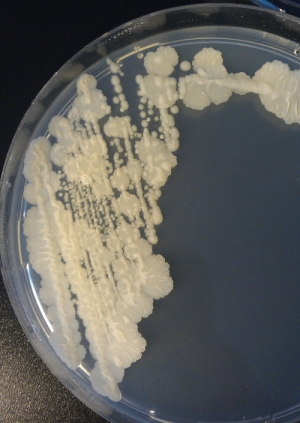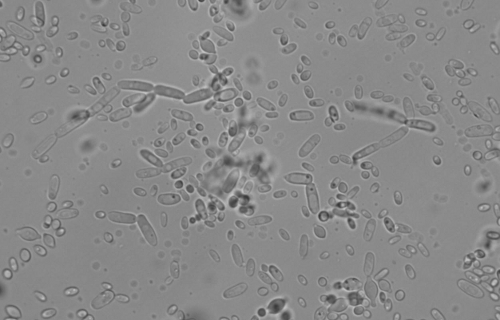Eureka, this is the second post in the pentade about some agar plates. The first post was about different dregs from commercial sour beers. This post is about a water kefir culture and a Lactobacillus starter. I made a Lactobacillus starter with sterile apple juice and dumped some acidified malt in there for a future Berliner Weisse. Made the starter a few days ago and it smells really sour. Lets get into the results.
Water kefir:
Plated my first water kefir on a Sabouraud plate to see what’s in there. I could observe only two kinds of colonies after three days of incubation:
– Off-white color, even, circular, glossy, convex, 2 mm diameter.
– White color, wavy, irregular, not glossy, flat, 10 mm diameter.
Since I had no idea what these colonies might be, I took a sample of each colony and did a microscopy analysis.
And now the really fun part begins: The circular colonies on the agar are no bacteria due to the size of the bugs. These must be some sort of yeasts. Maybe even more than one kind. But a kind of yeast that exists in a slender rather than in a circular form like brewers yeast (aka Saccaromyces). I have no idea what sort of yeast I have here.
And the wavy colonies look even more inhomogeneous than the circular colonies. But these are yeast cells as well due to the size. There are the slender ones again like in the picture above, and a kind of roundish smaller one as well. I have no idea what I got myself here. I expected to find some Lactobacillus bacteria on the plates since bacteria grow much faster than yeasts in general. But I could not find any. And no Lactobacillus on the microscopy samples as well. I guess that Sabouraud agar does not support the growth of Lactobacillus at all.
Comparing the two pictures gives me the impression that there are more than one different kind of yeasts. These results were very unexpected to me and I am quite fascinated what I got myself here.
Lactobacillus starter:
And for the starter: No sign of colony formation at all. Even after further incubation. This might prove that Sabouraud agar is indeed not a media to cultivate Lactobacillus bacteria. Unfortunately I do not have a microscopy picture of the Lactobacillus starter to show the bacteria.
Summary
What did I learn? First, Sabouraud might be unsuitable for cultivating Lactobacillus strains. Second of all, there are some sort of yeasts in the water kefir culture I could not identify further. Lets go back to the results from the first post about the dregs where I could observe only bacteria. The microscopy showed bacteria, Bacillus to be exactly. And I expected that the bacteria might be Lactobacillus or Acetobacter. As these results here showed that Lactobacillus might not grow on Sabouraud, I guess that the bacteria from the dregs must be Acetobacter then.
Did some research about the bugs in water kefir. Some sources state, that there are Candida strains or Kloeckera apiculata in there. I compared my pictures with published pictures of both yeasts and they looked very different to me.
I plated the different colonies on fresh Saboraud plates and will do further investigations.
If there is someone out there who can identify any of the bugs in the pictures, please comment below. And if someone has any ideas how/what to do next with the colonies, please let me know as well.
The next, third post about agar plates will be about some normal Saccaromyces strains.





